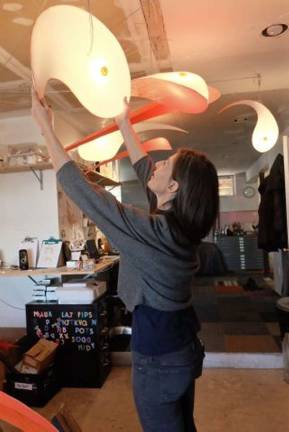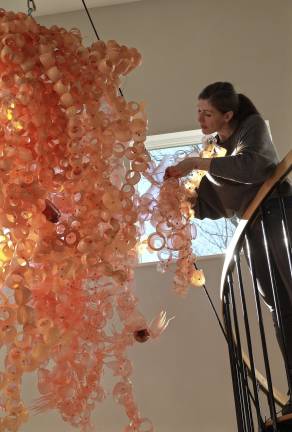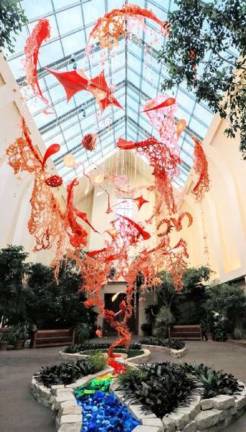Exploding the nightmare



Molded by childhood trauma, an artist finds the light in our ‘displaced abundance’
By Melissa Shaw-Smith
Aurora Robson arrived in New York at 18, a high school dropout on the back of a motorcycle with her life savings in her boot and a backpack filled with oil paints. Today, she is an artist renowned for large scale installations that she fashions out of raw materials intercepted from the plastic waste stream. Part of her latest installation, Arise, dangles from the ceiling in her dining room in Chester, NY. Sunlight glows through an ethereal cloud of orange air brushed plastic. Constructed out of hundreds of beverage bottles riveted together, the shapes have an organic quality, reminiscent of a coral reef, or what you might find in a seawater sample seen through a microscope. Destined for a botanical center in Omaha, Nebraska, the installation will have a stream of multicolored plastic bottle caps appearing to flow out of an indoor koi pond, rising up into a 60-foot vortex made of thousands of pieces of plastic.
This mountain of nonbiodegradable castoffs could be the stuff of nightmares. In fact, it was out of Robson’s own childhood nightmares that these protozoan formations originally evolved. Robson’s formative years were chaotic. Growing up in Hawaii, where her family had fled from Canada to outrun her dad’s legal problems, young Aurora often dreamt of a never-ending looping knot that continued in all directions, from whose negative spaces blobs would form and grow until she felt like she was going to suffocate.
Her first forays into art were paintings that transformed those nightmarish knots into color-drenched paisley explosions, her brush bringing harmony to the bedlam. In the years she spent living and working in the city, where she bartended, sang in a band, ran a welding studio and sculpted with metal, her art was part therapy, a way to “transform my own experiences into things that resonate with a positive frequency,” as she said in a TEDx talk. While she was working on one of these early paintings in her studio in Brooklyn, something caught her eye on the sidewalk outside, distracting her.
“It was literally like somebody was trying to get my attention with a mirror reflecting the light,” she said. “And I noticed this mound of knotted trash.”
The “curvilinear, diaphanous quality” of the plastic bottles looked a lot like what she was painting. It struck her that plastic was a very under-utilized medium for sculpture, and it was something being thrown away by the ton every day.
“Like most people, I had no idea plastic was a problem. I was like, I can make sculpture out of that. It’s free. Nobody’s doing that,” she said. “I just started playing. I got more and more inspired.”
A simple switch of medium, and Robson’s work instantly took on a new activist dimension. The stage was set for Robson to take her curvilinear therapy to a grander scale, transforming our collective nightmare – junk mail and beach jetsam – into something so beautiful you want to dive right in. Her pieces allow us to look, gawk, even marvel at what we’ve given rise to, for once, instead of averting our eyes.
“My goal in making art is to give people an opportunity to reflect on their own perception of value, so that we can all recognize that it isn’t just the letter, but the envelope that’s a gift,” Robson said in her TEDx talk. “In fact, all of this is. Waste is merely displaced abundance. Giving thought and attention and energy to matter is what makes something a piece of art and not a piece of trash.”
To get her hands on all this crap — er, displaced abundance — Robson often works with redemption centers, schools, municipalities, and communities. Sometimes she repurposes parts of previous works. At least once subcontracting with homeless people who were out collecting bottles on the New York City streets anyway.
“I paid them twice what they’d get at the redemption center,” said Robson. “The streets outside my studio were a whole lot cleaner, less stuff was entering the waterways, they were getting gainful employment, and I didn’t have to go digging around to look for art supplies myself. So that was a 15,000 bottle collection.”
Stored in a shipping container in Robson’s driveway in Chester is her epic collection of multi-colored bottle caps, which will form the stream connecting the fishpond to the vortex. The 10,000 visitors a month to the space, most of whom are school kids, will “be able to bring their own caps, and be co-creators of the piece,” said Robson. “Young people totally get this: No, this is not sustainable, we should do something about it.”
Robson’s studio these days is in her basement. Here, she and her husband Marshall Coles, a cinematographer who does the 3-D computer modeling and lighting for each exhibition, can work away and still be home when their two daughters get off the school bus. Robson uses water-based, non-toxic paint so as not to add to the problem she’s trying to solve. She points out the damaged highway safety drums and industrial plastic barrels that she’s fusing into the foundation of the installation, using a tool that’s a cross between an industrial welder and a hot glue gun. Even the scraps of plastic filament get saved. “I keep it all, so there’s zero waste in the studio.”
The welded pieces will be lit, by Coles, from inside by solar powered LEDs. Soon he’ll be packing the truck with the multiple components, and driving to Omaha where she’ll meet him and they’ll spend a couple of weeks putting the installation together in a Cathedral-roofed greenhouse.
Arise will join the parade of Robson’s pieces that have taken over grand spaces like corporate offices, universities, galleries and botanic centers around the country. Later this summer, she’ll install another outdoor sculpture made from plastic debris taken from the waste stream at Penn State in the university’s arboretum, for an exhibit titled Gravity Schmavity (other of her fun exhibit names include Repsychling, Anthroposcenery, and Makapiapia, which is Hawaiaan for the sleep crust that glues your eyelids shut). All this from a woman who had to hire a stand-in to talk about her plastic sculptures at her first art show because she was so shy.
In 2012, Robson was invited to create and teach a college course about her practice. She developed this curriculum called Sculpture and Intercepting the Waste Stream. The idea, she explained, is that you get the kids to do a cleanup (shore, river, park, roadside) and make a piece for an exhibit at the end, which doubles as a fundraiser to support stewardship efforts in their area. She taught and tweaked the course at a few different colleges, and now her syllabus is an open-source course being taught in colleges and high schools around the US.
“Anyone trying to intercept the waste stream solo, as an individual, it’s just too depressing, you feel powerless, like your actions don’t make a difference,” said Robson. “But if you do it collectively it’s so much more empowering and effective and fun.”
Last summer, Robson worked with kids at her daughters’ summer camp to eliminate disposable water bottles and switch to reusable ones. They used the plastic bottles they’d cleaned up to make a giant turtle they floated on a pond. Next summer it will be joined by other creatures at risk from ingesting plastic waste in our waterways.
“It’s all about finding resolution in conflicts,” said Robson. “If something is going in a really bad direction, it has motion, so you can shift that direction. As long as there’s motion, there’s still hope.”